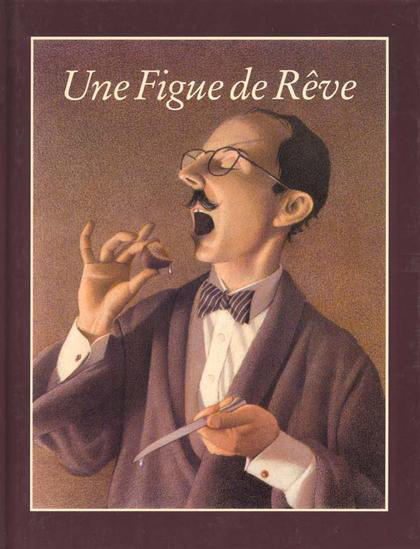by Chris Van Allsburg
Monsieur Bibot, dentiste cupide et infâme, vit avec son petit chien blanc dans un appartement immaculé. Voilà qu’en paiement de ses honoraires, une vieille dame lui donne deux figues magiques réalisant les rêves, mais l’odieux personnage la jette dehors. Le soir, il dévore l’un des fruits. Ses rêves de milliardaire virent au cauchemar. Sous son air respectable, Monsieur Bibot nous ouvre les portes d’un monde étrange.
Strategies/Skills Used
Reading Strategy 6: Connect what you read with what you already know.
Reading Strategy 11: Make inferences and draw conclusions.
Reading Strategy 12: Reflect and respond.
Writing Skill 1: I generate ideas in a variety of ways.
Writing Skill 5: I carefully choose the most effective words to express my ideas.
Writing Skill 6: I choose the tone and point of view that suit my writing purpose.
Writing Skill 7: I use my personal style to make my writing unique.
 TEACHING THE ACTIVITY: PRE-READING
TEACHING THE ACTIVITY: PRE-READING
(1) Using the Zoom In strategy, students will observe a portion of an image closely and develop and record a hypothesis about it. When new visual information is presented, ask students to again look closely and reassess their initial interpretation in light of the new information to develop and write down a new hypothesis.
(2). Have each student fold two pieces of 8 x 11 paper in four to create four quadrants on each page. In these quadrants, students will record their thinking and hypotheses about two separate illustrations, each revealed in four steps.
(3) Reveal the image on pages 10–11 in the four steps outlined below:
- The dentist’s face only
- The dentist and cabinets (but do not show the pliers)
- The dentist with cabinets and the pliers
- The whole image, finally revealing the patient under the dentist’s hand
(4) Reveal the image on pages 22–23 in the four steps outlined below:
- The dentist’s face only
- The bottom half of page 23
- The bottom half of pages 22–23
- The full image, finally revealing the Tour Eiffel
(5) As you progress through the reveals, lead a group discussion with questions such as “What do you see?” “What do you think the relationship is between these two people?” “Do you have a prediction about what the next part of the picture will look like?” “How has your thinking changed with this new information?” “What would the effect have been if the reveals had happened in a different order?” Encourage the class to share their hypotheses. Based on all the information gathered from the illustrations, students predict what they think this story is about and what might happen.
 TEACHING THE ACTIVITY: DURING READING
TEACHING THE ACTIVITY: DURING READING
(6) Read the story aloud and pause after reading the text that accompanies each of the following three illustrations: #1 on pages 12–13, #2 on pages 20–21, #3 on pages 34–35.
 (7) Using the activity Thinking Boxes and the Graphic Organizer Les boîtes d’idées, allow students to record their thinking about each image. In the thought and speech bubbles, ask students to write down what they have inferred the character is thinking and saying at this point in the story. There are three boxes on the Graphic Organizer, one box for each image.
(7) Using the activity Thinking Boxes and the Graphic Organizer Les boîtes d’idées, allow students to record their thinking about each image. In the thought and speech bubbles, ask students to write down what they have inferred the character is thinking and saying at this point in the story. There are three boxes on the Graphic Organizer, one box for each image.
(8) Have students share their ideas in an Inside Outside Circle:
- Students in the outside circle share their ideas, while inside partners listen.
- After a minute or two, have the outside partners rotate once to the right.
- Repeat process three to five times.
- Now, have students in the inside circle switch places and switch roles with students in the outside circle.
- Repeat the process, as outlined above, for the new outside circle.
(9) Lead a group discussion after the Inside Outside Circle activity is complete, calling attention to surprises and differences in ideas and thinking.
 TEACHING THE ACTIVITY: POST-READING
TEACHING THE ACTIVITY: POST-READING
(10) Explain to students that they are going to explore this story from a different perspective…that of the dog or the old lady!
(11) Using the Walk on the Wild Side strategy, students will consider other points of view and eventually retell the story from a new perspective while considering some of the following: “What stands out to you?” “What are you focusing on?” “What do you smell?” “What do you hear?” “What’s your environment like?” “What are you thinking?” “What are you feeling?”
(12) Provide students with enough time to develop their stories and give them the opportunity to share their stories.
(13) Ask students to reflect on the story from another perspective. “Was it difficult to see the story through new eyes?” “Why is it important for authors to consider different points of view?” “How might the author use this information to his advantage?”
 TEACHING THE ACTIVITY: POST-READING EXTENSIONS
TEACHING THE ACTIVITY: POST-READING EXTENSIONS
Using the Great First Lines strategy as a guideline, have students brainstorm favorite first lines or expressions they feel are represented in this story. Guide their thinking towards “Be careful what you wish for!” if they do not come up with it first. Based on the moral of this story, have students tell a personal story or make one up that also conveys the idea of being careful of what you wish for.
